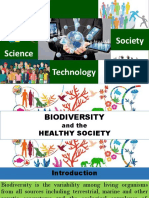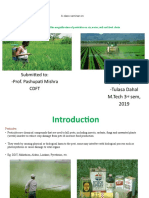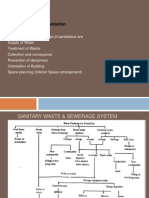Bioaccumulation Reading Material
Bioaccumulation Reading Material
Uploaded by
anjujeanCopyright:
Available Formats
Bioaccumulation Reading Material
Bioaccumulation Reading Material
Uploaded by
anjujeanCopyright
Available Formats
Share this document
Did you find this document useful?
Is this content inappropriate?
Copyright:
Available Formats
Bioaccumulation Reading Material
Bioaccumulation Reading Material
Uploaded by
anjujeanCopyright:
Available Formats
BIOACCUMULATION
Definition
Bioaccumulation refers to the gradual accumulation of substances, such as
toxins or pollutants, in the tissues of organisms over time. These substances
can come from various sources in the environment, including air, water, and
food.
Examples
Here are some examples of bioaccumulation:
•Mercury accumulating in fish in a polluted lake
•Pesticides building up in the bodies of insects
•Heavy metals accumulating in shellfish in a contaminated river
•Chemicals from plastic pollution accumulating in the tissues of marine
animals
Process and Effects
Bioaccumulation occurs when an organism absorbs a substance at a faster rate
than it can eliminate or metabolize it. This leads to an accumulation of the
substance in the organism's tissues. As the organism consumes more
contaminated food or water, the concentration of the substance in its body
increases.
The effects of bioaccumulation can vary depending on the specific substance
and the organism involved. Some organisms may be more tolerant to certain
substances and can withstand higher levels of accumulation. However, for
many organisms, bioaccumulation can lead to harmful effects, such as impaired
reproduction, organ damage, and even death.
Factors Contributing to Bioaccumulation
Several factors contribute to the process of bioaccumulation:
Persistence of the substance: Substances that are resistant to degradation or
breakdown tend to bioaccumulate more easily.
Solubility : Substances that are highly soluble in fats or lipids are more likely to
accumulate in organisms.
Trophic level: Organisms higher up in the food chain, such as top predators, are
more prone to bioaccumulation as they consume other organisms with
accumulated substances.
Exposure duration and concentration: Longer exposure to higher concentrations
of a substance increases the likelihood of bioaccumulation.
Impact on Ecosystems
Bioaccumulation can have significant impacts on ecosy stems. As substances
accumulate in organisms, they can disrupt the balance of the food chain. Top
predators, which accumulate higher concentrations of substances, may
experience population declines or even extinction. Additionally,
bioaccumulation can affect the overall health and biodiversity of ecosy stems.
Risks to Human Health and the Environment
Bioaccumulation poses risks to both human health and the environment.
Humans can be exposed to accumulated substances through the consumption of
contaminated food or water. Depending on the substance and its concentration,
this can lead to various health problems, such as neurological disorders, cancer,
and reproductive issues.
In addition to human health risks, bioaccumulation can have detrimental
effects on the environment. It can contribute to the degradation of ecosy stems,
loss of biodiversity, and disruption of ecological processes.
Strategies and Solutions
To minimize the effects of bioaccumulation and promote a healthier
environment, the following strategies and solutions can be implemented:
Regulating the use and release of toxic substances
Implementing proper waste management practices
Promoting sustainable agricultural practices
Encouraging the use of alternative energy sources
Raising awareness and educating the public about bioaccumulation and its
consequences
K ey Con cept s
• Bioaccumulation can occur in various organisms,
including fish, birds, and mammals.
• Persistent organic pollutants (POPs) are a group of
substances that are known for their tendency to
bioaccumulate and can have long-lasting effects on
ecosystems.
• Bioaccumulation can be measured using biomagnification
factors (BMFs), which indicate the increase in
concentration of a substance from one trophic level to the
next in a food chain.
• Monitoring and research play a crucial role in
understanding and managing the risks associated with
bioaccumulation.
You might also like
- Qatar Storm Drainage ManualDocument97 pagesQatar Storm Drainage Manualkashif100% (3)
- Environmental Law Notes KSLU Grand FinalDocument70 pagesEnvironmental Law Notes KSLU Grand FinalPraveen r n100% (1)
- Biomagnification - Biomagnification, Also Known As Bioamplification or Biological MagnificationDocument3 pagesBiomagnification - Biomagnification, Also Known As Bioamplification or Biological Magnificationgacoso10No ratings yet
- BioaccumulationDocument4 pagesBioaccumulationxenmii3891No ratings yet
- Biomagnification: Free EncyclopediaDocument4 pagesBiomagnification: Free EncyclopediaHimanshuPrajeshNo ratings yet
- Biological MagnificationDocument2 pagesBiological MagnificationKhassmeen Delos Santos AradaniNo ratings yet
- Xeno AssignmentDocument8 pagesXeno AssignmentAdityaNo ratings yet
- Food PreservationDocument24 pagesFood PreservationMukeshChhawariNo ratings yet
- Bioaccumulation-article-and-Questions-1paib9qDocument5 pagesBioaccumulation-article-and-Questions-1paib9qvanhelsing4170No ratings yet
- EcosystemDocument6 pagesEcosystemklbibek0407No ratings yet
- BIOMAGNIFICATIONDocument11 pagesBIOMAGNIFICATIONJatin SehrawatNo ratings yet
- Food Spoilage and Its Prevention: Report OnDocument10 pagesFood Spoilage and Its Prevention: Report OnEvent ManagerNo ratings yet
- Excretion Is The Exit of A SubstanceDocument2 pagesExcretion Is The Exit of A SubstanceRonna MaeNo ratings yet
- Course: Food Safety: Department of Food and Bioresource TechnologyDocument34 pagesCourse: Food Safety: Department of Food and Bioresource TechnologyNgangjoh AlimaNo ratings yet
- Bioaccumalation and Bio Magnification EssayDocument6 pagesBioaccumalation and Bio Magnification Essayapi-305791685No ratings yet
- Gut Health in 4 (Easy) StepsDocument2 pagesGut Health in 4 (Easy) StepsInternational Aquafeed magazineNo ratings yet
- Environment Pollution and Global Climatic ChangeDocument81 pagesEnvironment Pollution and Global Climatic ChangeHalimaNo ratings yet
- Industrial Microbiology & Food ProcessingDocument35 pagesIndustrial Microbiology & Food ProcessingKaushik LanjekarNo ratings yet
- Microbiology of WastewaterDocument5 pagesMicrobiology of WastewaterAnupriyaNo ratings yet
- 202004061923051615omkar Zool BioaccumulationDocument3 pages202004061923051615omkar Zool Bioaccumulationxenmii3891No ratings yet
- Biomagnification: A Report OnDocument13 pagesBiomagnification: A Report OnHarsh RawatNo ratings yet
- Pollution Indicators and Pollution Control StrategiesDocument46 pagesPollution Indicators and Pollution Control StrategiesUZMA KHANNo ratings yet
- Biodiversity Conservation: Thecla M. MutiaDocument9 pagesBiodiversity Conservation: Thecla M. Mutiahsdf,asghNo ratings yet
- Des 5.3Document5 pagesDes 5.3Pradeep gmailNo ratings yet
- STS Module 12 Biodiversity and The Healthy Society EnhancedDocument44 pagesSTS Module 12 Biodiversity and The Healthy Society EnhancedRyan Fernandez Dela Cruz100% (1)
- Marine Pollution and Prevention-CleverDocument3 pagesMarine Pollution and Prevention-CleverTochukwu CollinsNo ratings yet
- Biodiversity and The Healthy SocietyDocument27 pagesBiodiversity and The Healthy Societysharielles /100% (2)
- Research Project Zoology BSC Last YearDocument23 pagesResearch Project Zoology BSC Last Yearjogipalk92No ratings yet
- Factors Affecting Growth and SurvivalDocument26 pagesFactors Affecting Growth and Survivalurmila choudharyNo ratings yet
- Biodiversity and The Healthy SocietyDocument4 pagesBiodiversity and The Healthy SocietyLore Anne Mhae Santos100% (1)
- JOASHEDocument3 pagesJOASHErobertmuhirwa7No ratings yet
- Asia Pacific College of Advanced Studies College Department Gec StsDocument5 pagesAsia Pacific College of Advanced Studies College Department Gec StsKen lopezNo ratings yet
- Unit 1 Food MicrobiologyDocument8 pagesUnit 1 Food MicrobiologysreelekhakotamrajuNo ratings yet
- Food SpoilageDocument42 pagesFood Spoilagedrgunavet100% (7)
- Vibin VDocument16 pagesVibin Vdhanushsindhu7920No ratings yet
- The Chemistry of The Environment GROUP 2Document37 pagesThe Chemistry of The Environment GROUP 2Joel Jr GanabesNo ratings yet
- ESS AnswerDocument9 pagesESS Answerjia mehraNo ratings yet
- Lecture 1bDocument17 pagesLecture 1bZainab AbdullahNo ratings yet
- Jisrael Ompad - UloeDocument4 pagesJisrael Ompad - UloeJisrael OmpadNo ratings yet
- Bio MagnificationDocument6 pagesBio Magnificationmukesh bhatiNo ratings yet
- Basic Ecological Concepts and PrinciplesDocument8 pagesBasic Ecological Concepts and PrinciplesangkatekagNo ratings yet
- Biodiversity and The Healthy SocietyDocument40 pagesBiodiversity and The Healthy Societyzeikcereno6No ratings yet
- Different Methods of Food PreservationDocument22 pagesDifferent Methods of Food Preservationanand jeughaleNo ratings yet
- Submitted To: - Prof. Pashupati Mishra CDFT: Submitted By: - Dikshya Shrestha - Tulasa Dahal M.Tech 3 Sem, 2019Document25 pagesSubmitted To: - Prof. Pashupati Mishra CDFT: Submitted By: - Dikshya Shrestha - Tulasa Dahal M.Tech 3 Sem, 2019Dixya Shrestha100% (1)
- General Principles of Food Preservation-Physical MethodsDocument12 pagesGeneral Principles of Food Preservation-Physical MethodsEMBRYOLOGY PFCNo ratings yet
- L 10 Biodiversity and Healthy EcosystemDocument25 pagesL 10 Biodiversity and Healthy EcosystemJane Harris PalbanNo ratings yet
- To Study The Effect of Potassium Bisulphite As A Food Preservative Under Conditions (Temperature, Concentration and Time)Document14 pagesTo Study The Effect of Potassium Bisulphite As A Food Preservative Under Conditions (Temperature, Concentration and Time)ashishstomar53% (15)
- Emergence of BiochemistryDocument4 pagesEmergence of BiochemistryJhon Rey LagosNo ratings yet
- Gmo, Biodiversity and Climate ChangeDocument38 pagesGmo, Biodiversity and Climate ChangePaulo Mendoza FelicianoNo ratings yet
- Biodiversity and ConservationDocument6 pagesBiodiversity and Conservationrakesh.lilasiNo ratings yet
- Food Microbiology Principles of Spoilage Unit 1 2012Document3 pagesFood Microbiology Principles of Spoilage Unit 1 2012nyombikhalfan4No ratings yet
- Bio AccumulationDocument15 pagesBio AccumulationOghomwen OsundeNo ratings yet
- Dioxins - WHODocument5 pagesDioxins - WHOQS Yakult mojokertoNo ratings yet
- Science, Technology and Society Hand-Out Title: Biodiversity and Health Society BiodiversityDocument21 pagesScience, Technology and Society Hand-Out Title: Biodiversity and Health Society BiodiversityAngela CubillaNo ratings yet
- Treated Effluent DisposalDocument5 pagesTreated Effluent DisposalvipinNo ratings yet
- Food PreservationDocument14 pagesFood PreservationÂyuŠh kanĐwÁLNo ratings yet
- Lesson 10: Biodiversity and The Healthy SocietyDocument2 pagesLesson 10: Biodiversity and The Healthy SocietyApril Dream Dellava100% (1)
- Biodiversity and The Healthy SocietyDocument3 pagesBiodiversity and The Healthy SocietyKJ PacamparaNo ratings yet
- Biodiversity and The Healthy SocietyDocument4 pagesBiodiversity and The Healthy Societymarcelinoarabella14No ratings yet
- Bioliving In Today's World: Adapt to This Great New Way of LivingFrom EverandBioliving In Today's World: Adapt to This Great New Way of LivingNo ratings yet
- Vegan Parenting: Raising the Next Generation of Earth StewardsFrom EverandVegan Parenting: Raising the Next Generation of Earth StewardsNo ratings yet
- Sky Quiz BeeDocument19 pagesSky Quiz Beemariaisabel.bolidoNo ratings yet
- Environmental HealthDocument4 pagesEnvironmental HealthXris Loidz GanadoNo ratings yet
- 3 Hours / 70 Marks: Seat NoDocument4 pages3 Hours / 70 Marks: Seat Nodesaidhiraj37No ratings yet
- 1 Basel Movement FormDocument4 pages1 Basel Movement FormSreejith SreekumarNo ratings yet
- 18012021031702Document16 pages18012021031702Johny SinghNo ratings yet
- Waste Water Treatment ProcessDocument287 pagesWaste Water Treatment Processmdirsan100% (2)
- Refresher Design 101-213Document7 pagesRefresher Design 101-213Dash SmthNo ratings yet
- Pco Accreditation FormDocument3 pagesPco Accreditation FormJan GarciaNo ratings yet
- Asian Water Technology PVTDocument11 pagesAsian Water Technology PVTSumeena MattooNo ratings yet
- EThekwini Municipality Policies and Practices of The Water and Sanitation UnitDocument113 pagesEThekwini Municipality Policies and Practices of The Water and Sanitation UnitDravith BakoolNo ratings yet
- M 600 BrochureDocument2 pagesM 600 BrochurecleanwaterNo ratings yet
- ProjectDocument52 pagesProjectSreenithi Samaga 104 32No ratings yet
- Pre Feasibility Report For Welspun Iron & Steel Pvt. LimitedDocument25 pagesPre Feasibility Report For Welspun Iron & Steel Pvt. LimitedkalaiNo ratings yet
- Heavy Metals Contamination in Waste-WaterDocument5 pagesHeavy Metals Contamination in Waste-WaterSachin SrivastavaNo ratings yet
- Septic Tank Purpose - FunctionDocument35 pagesSeptic Tank Purpose - FunctionMasnun Rahman100% (3)
- Sewer Siphon Assessment and Air Jumper Design: WEFTEC®.06Document24 pagesSewer Siphon Assessment and Air Jumper Design: WEFTEC®.06Ayman RiyadhNo ratings yet
- Green and Energy Efficient Buildings - : Case Study of Bangalore & MysoreDocument47 pagesGreen and Energy Efficient Buildings - : Case Study of Bangalore & MysoreYOGITH B NAIDU YOGITH B NAIDUNo ratings yet
- Minutes of MeetingDocument2 pagesMinutes of MeetingAneesch PreethaNo ratings yet
- Swamanorath BrochureDocument6 pagesSwamanorath BrochureRishabh SansanwalNo ratings yet
- Basic Principles of SanitationDocument44 pagesBasic Principles of SanitationKaushik Jayaveeran67% (12)
- Well Fact Sheet: Well Owner ResponsibilitiesDocument2 pagesWell Fact Sheet: Well Owner ResponsibilitiesHill County Conservation DistrictNo ratings yet
- Water Trash Removel SystemDocument25 pagesWater Trash Removel Systemrock starNo ratings yet
- Slow Sand Filtration: Design, Operation, and Maintenance: Jan Teun VisscherDocument5 pagesSlow Sand Filtration: Design, Operation, and Maintenance: Jan Teun VisscherAhtisham KhanNo ratings yet
- 0680 Environmental Management: MARK SCHEME For The May/June 2011 Question Paper For The Guidance of TeachersDocument5 pages0680 Environmental Management: MARK SCHEME For The May/June 2011 Question Paper For The Guidance of TeachersHK BeatsNo ratings yet
- Felix Ziad Karim Water ProjectDocument2 pagesFelix Ziad Karim Water Projectapi-251369588No ratings yet
- DSR Micro ProjectDocument23 pagesDSR Micro Projectakhileshpawar095No ratings yet
- MSDS (E) - Compressor RA-X 46Document4 pagesMSDS (E) - Compressor RA-X 46Unurbat ByambajavNo ratings yet
























































































